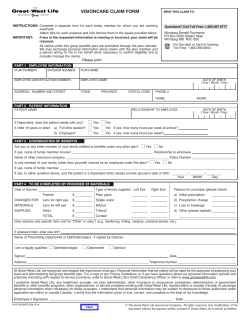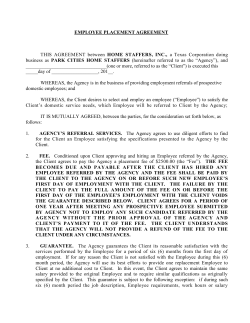
PLAN FORMATION IN What is a 457 deferred compensation program?
PLAN INFORMATION Plan Features and Highlights What is a 457 deferred compensation program? What are the advantages of Roth savings? A number of contributory retirement programs are defined in the Internal Revenue Code. These include Section 457 programs, commonly called 457 deferred compensation programs. Deferred compensation programs allow eligible employees to save and invest before-tax dollars through voluntary salary deferrals, supplementing any existing retirement/pension benefits. Employee contributions and any earnings grow tax deferred until the money is withdrawn, usually at retirement when the participant is typically receiving less income and may be in a lower federal income tax bracket than while working. Withdrawals are subject to ordinary federal income tax. You also have the option to contribute to a Roth 457 account, which allows you to save after-tax. For enrollment information, call toll free (877) SAV-N-RET (877-728-6738); you will be connected to the local office in Indiana once you answer "yes" on the initial prompt.1,2 Roth contributions are made with after-tax dollars. Roth 457 contributions reduce your take-home pay because you pay taxes on your Roth 457 contribution up front, rather than deferring those taxes until you take a distribution. Who is eligible to participate in the Hoosier S.T.A.R.T. Deferred Compensation Plan, and why should I participate? All qualified State employees, as well as the employees of more than 260 local government units, are eligible to participate in the Plan. Participating in Hoosier S.T.A.R.T. may help provide a more comfortable and secure financial future. Not only can you save and invest on a tax-advantaged basis, but the Hoosier S.T.A.R.T. Plan offers quality investment options, local service representatives, financial education services, and planning tools that can help you better prepare for retirement. What are the advantages of before-tax savings? With before-tax savings, you pay no income taxes on any contributions or any earnings until you withdraw the money. This leads to the benefit of compounding—that is to say, generating returns on money that you would have paid in taxes if those taxes were not deferred. Any earnings are reinvested in your account, where they have the potential for continued growth because they are not reduced by taxes each year. Is there any reason why I should not participate in the Plan? Participating may not be advantageous if you are experiencing financial difficulties, have excessive debt, or do not have an adequate emergency fund (typically in an easy-to-access account). CONTRIBUTION AMOUNTS What is the 457 Plan contribution amount? The minimum contribution amount is 0.5% of includible compensation. You can contribute a maximum of 100% of includible compensation, not to exceed the tax code's limit of $17,500 in 2014. If you are within the three calendar years that end prior to the calendar year of your normal retirement age, you may be eligible to use the Standard Catch-Up provision that allows you to save up to an additional $17,500 in 2014. This amounts to a total possible contribution of up to $35,000 in 2014. If you are age 50 or older during the 2014 calendar year, you may take advantage of the Age 50+ Catch-Up provision and contribute an additional $5,500 in 2014. The Age 50+ Catch-Up provision and the Standard Catch-Up provision cannot be used in the same calendar year. Please see your service representative for more information. State employees receive a $15 per paycheck matching contribution. Employees of counties, cities, towns or other political subdivisions may be eligible to receive a matching contribution. Please check with your Plan sponsor. 1Access to KeyTalk® and the website may be limited or unavailable during periods of peak demand, market volatility, systems upgrades/maintenance or other reasons. Transfer requests made via the website or KeyTalk received on business days prior to close of the New York Stock Exchange (4:00 p.m. Eastern Time or earlier on some holidays or other special circumstances) will be initiated at the close of business the same day the request was received. The actual effective date of your transaction may vary depending on the investment option selected. 2 All references herein to 457(b) programs are to governmental 457(b) plans. May I increase or decrease my contribution amount? You can increase, decrease or stop your contribution by completing a Salary Deferral Agreement and submitting it to Hoosier S.T.A.R.T. or by calling (877) SAV-N-RET (877-728-6738); you will be connected to the local office in Indiana once you answer "yes" on the initial prompt. State employees can now change their deferral amounts online at www.hoosierstart.in.gov.1 INVESTMENT CHOICES What are my investment option choices, and how do I know which investment choices are right for me? You can choose from the current array of 25 investment options: • Ten age-based portfolios • One stable value option • Fourteen direct investment options The menu of investments is selected and monitored by the Indiana Deferred Compensation Committee and its investment consultant to help ensure that the Plan offers high-quality investment opportunities over time. Current investment options are described in the investment option fund overviews located at www.hoosierstart.in.gov. Investment option information is also available through KeyTalk® at (877) SAV-N-RET (877-728-6738). Both services are available to you 24 hours a day, seven days a week.1 We recommend you consult with your investment advisor before making investment decisions. How can I get help choosing my investment options? Your Hoosier S.T.A.R.T. Deferred Compensation Plan offers Reality Investing® Advisory Services (Advisory Services), brought to you by Advised Assets Group, LLC (AAG), a federally registered investment adviser and wholly owned subsidiary of Great-West Life & Annuity Insurance Company. Advisory Services may help you create a personalized retirement strategy. With Advisory Services, you can choose the Managed Account service, through which an investment advisory services firm manages your retirement account for you.3 If you prefer to manage your retirement account on your own, you can use Online Investment Guidance and Online Investment Advice. For more detailed information, log in to the website at www.hoosierstart.in.gov and click on Access Your Account, About Your Plan, and Investment Information, and then click on the Reality Investing tab. You may also call (800) 888-4952, extension 41066, to speak to an AAG adviser representative. There is no guarantee that participation in Reality Investing Advisory Services, including the Managed Account service, will result in a profit or that your account will outperform a self-managed portfolio. ACCOUNT MANAGEMENT How do I make investment option changes? Access the website by entering your Username, which is your Social Security number (SSN) for your initial login, and the Personal Identification Number4 (PIN) that has been mailed to you. The first time you log in, you will be prompted to change your Username. To access your account via KeyTalk, you will always use your SSN and PIN. Both services enable you to: • Move all or a portion of your existing balances among investment options (subject to Plan rules and fund redemption fee policies, if any). • Change how your payroll contributions are allocated among your investment options. How do I keep track of my account, and when will I receive my statements? An account statement will be mailed to your address on file on a quarterly basis every January, April, July and October, showing your account balance and activity for the quarter. You may also review your account online using your self-selected Username and PIN. Your account balances are updated daily online, and you can customize your account page to display the information you are most interested in seeing. Some of the features included on your statement are your account balance, at-a-glance graphics of your asset allocation, and an account summary by contribution source. If you would rather receive your statements electronically and no longer wish to receive a paper statement in the mail, sign up on the website for the electronic delivery option. ROLLOVERS Can I combine assets from my other retirement plans into my before-tax Hoosier S.T.A.R.T. account?5 Yes. You may now consolidate your retirement accounts (457(b), 401(k), 403(b) and IRA) into your Deferred Compensation Plan. However, all non-457 program assets transferred into a 457 program remain subject to an early withdrawal penalty that does not apply to 457 program assets. In addition, 457 program assets transferred into another program (IRA, 401(k), 403(b), etc.) may become subject to the early withdrawal penalty when distributed from the new non-457 program. 3Representatives of GWFS Equities, Inc. are not registered investment advisors and cannot offer financial, legal or tax advice. Please consult with your financial planner, attorney and/or tax advisor as needed. 4The account owner is responsible for keeping the assigned PIN confidential. Please contact Great-West FinancialSM immediately if you suspect any unauthorized use. Can I combine assets from my other retirement plans into my Roth Hoosier S.T.A.R.T. account? Yes. You may transfer a prior employer-sponsored Roth account into the Hoosier S.T.A.R.T. Roth 457(b) Plan. However, the Plan does not allow you to transfer IRAs into your Roth account.5 What should I do with my account balance if I leave employment with the State? You have two choices when you leave employment: 1. You can leave your money in Hoosier S.T.A.R.T. and continue to take advantage of the diverse selection of investment options, account management tools, and dedicated service representatives. 2. You may also transfer your account balance to another eligible 457 program if your new employer accepts this type of transfer. You may also roll over your account balance to a 401(a), 401(k) or 403(b) program or IRA; but remember that your 457 assets may then become subject to an early withdrawal penalty if distributed prior to age 59½.5 DISTRIBUTIONS When can I withdraw the money from my before-tax contributions? Your money may be withdrawn only when you: • Retire • Experience an unforeseeable emergency within the Plan guidelines (see your Hoosier S.T.A.R.T. representative for additional details) • Die (your designated beneficiary(ies) will receive your benefits) • Terminate employment You are required to take your first required minimum distribution by April 1 of the calendar year following the later of: (1) the calendar year in which you reach 70½, or (2) the calendar year in which you retire from the State of Indiana. When can I withdraw the money from my Roth contributions tax-free? If a distribution is made from your Roth 457 account before you reach age 59½ and it is not due to death or disability, or reaching the five-tax-year period beginning with your first Roth contribution, you will pay income taxes on any earnings that are distributed. Otherwise, there is no income tax due on the Roth contributions distributed from the Plan because the contributions were made with after-tax dollars. What are my distribution options? When you are eligible for a distribution, you may: • Leave the value of your account in Hoosier S.T.A.R.T. until a future date • Receive: • Periodic payments • A lump-sum payment • A partial lump-sum payment • Roll over or transfer to another eligible plan (but be aware that some services in Hoosier S.T.A.R.T. may not be available in another plan)5 What happens to my money when I die? If you die before you select a payment distribution method, your designated beneficiary(ies) will receive the full value of your account. If you die after you have selected a payment distribution method, your beneficiary(ies) may continue with the existing payout method or change the payout method. Your beneficiary(ies) will need to contact Great-West FinancialSM to discuss the available options and apply for a distribution. If you die without designating a beneficiary, benefits will be paid to your estate in a lump sum. TAXES Do I report any current earnings/losses on my account(s) to the IRS? No. You do not need to report any current earnings/losses from your account(s) on your federal income tax forms. Any earnings on your before-tax contributions are tax-deferred until withdrawn, usually at retirement. Withdrawals from your before-tax account are subject to ordinary income tax at the time of payment. Your Roth distributions are income tax-free if you withdraw your Roth contributions and any earnings after holding the account for at least five tax years and: • You are at least age 59½; or • You become disabled; or • You die (after which your beneficiaries will take the withdrawal). 5You are encouraged to discuss rolling money from one account to another with your financial advisor/planner, considering any potential fees and/or limitation of investment options. How much income tax will be withheld from my before-tax distribution? Distribution withholdings will vary depending on the type of distribution you request. Generally, the mandatory 20% federal income tax withholding will apply to distributions unless you elect a direct rollover of the entire amount or take periodic payments that last longer than 10 years. Currently, Indiana does not mandate state income tax withholding at the time of distribution. The Plan will withhold state income taxes upon request. A Form 1099-R for the distribution amount will be mailed to you by January 31 of the year(s) following the year(s) in which you receive a distribution. How much income tax will be withheld from my Roth distribution? Your Roth distribution is income tax-free if you withdraw your Roth contributions and any earnings after holding the account for at least five tax years and: • You are at least age 59½; or • You have a disability; or • You die (after which your beneficiaries will take the withdrawal). If a distribution is made without meeting the qualifications listed above, you will pay ordinary income taxes on any earnings that are distributed. FEES Are there any recordkeeping or administrative fees to participate in Hoosier S.T.A.R.T.? Recordkeeping and Administrative Fees The Hoosier S.T.A.R.T. administrative fee is waived for the six-month period immediately following enrollment. After that period, your quarterly fee to participate in the Plan is $14.45. There may be other administrative service fees that apply to elective Plan features used by a participant. options you select. Funds may impose redemption fees and/ or restrictions on certain transfers, redemptions or exchanges if assets are held for less than the period stated in the fund’s prospectus and other disclosure documents. For more information, please refer to the fund’s prospectus and/or disclosure documents. Advisory Services Fees If you choose the Managed Account service provided by AAG, the annual fee will be based on your account balance (see table below). For example, if your account balance is $50,000, the annual Managed Account fee would be 0.60% of the account balance. If your account balance is $500,000, the first $100,000 would be subject to an annual fee of 0.60%; the next $150,000 would be subject to an annual fee of 0.50%; the next $150,000 would be subject to an annual fee of 0.40%; and any amounts over $400,000 would be subject to an annual fee of 0.30%. The fee is based on your account balance on the day the fee is debited, and it will be deducted from your account quarterly within the last five to seven business days of each quarter. If you cancel participation in the Managed Account, the fee will be based on your account balance on the date of cancellation and will be deducted within five to seven business days of the cancellation date. Participant Account Balance Annual Managed Account Fee Less than $100,000 0.60% Next $150,000 0.50% Next $150,000 0.40% Greater than $400,000 0.30% Your Plan also charges an annual fee of $25 for the Online Investment Advice tool, which is assessed to your account at $6.25 quarterly. There is no fee for Online Investment Guidance. Investment Management Fees There are investment management fees (also known as expense ratios) that vary by investment option. These fees are deducted by each investment option’s management company (not by Hoosier S.T.A.R.T. or Great-West Financial) before the daily price or performance is calculated to pay for trading and other management expenses. You can find your Plan’s investment option expense ratios on the website or in your Plan’s performance report. Each fund has its own fund operating expenses that vary depending on the investment Core securities, when offered, are offered through GWFS Equities, Inc. and/or other broker dealers. GWFS Equities, Inc., Member FINRA/SIPC, is a wholly owned subsidiary of Great-West Life & Annuity Insurance Company. Great-West FinancialSM refers to products and services provided by Great-West Life & Annuity Insurance Company (GWL&A), Corporate Headquarters: Greenwood Village, CO, its subsidiaries and affiliates. Managed Accounts, Guidance and Advice services are offered by Advised Assets Group, LLC (AAG), a federally registered investment adviser and wholly owned subsidiary of GWL&A. More information can be found at www.adviserinfo.sec.gov. The trademarks, logos, service marks, and design elements used are owned by their respective owners and are used by permission. ©2013 Great-West Life & Annuity Insurance Company. All rights reserved. Form# CB1069PH (12/2013) PT187686
© Copyright 2025




















